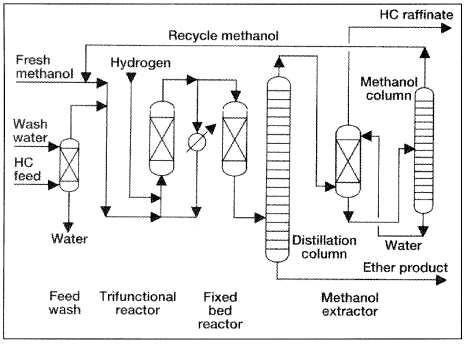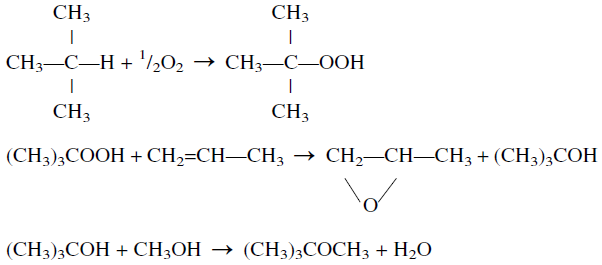
Methyl Tertiary Butyl Ether ((CH3)3C-O-CH3)
 المؤلف:
sami matar & Lewis. F. Hatch
المؤلف:
sami matar & Lewis. F. Hatch
 المصدر:
Chemistry of PETROCHEMICAL PROCESSES
المصدر:
Chemistry of PETROCHEMICAL PROCESSES
 الجزء والصفحة:
p 159
الجزء والصفحة:
p 159
 15-8-2017
15-8-2017
 4857
4857
Methyl Tertiary Butyl Ether ((CH3)3C-O-CH3)
MTBE is produced by the reaction of methanol and isobutene:


The reaction occurs in the liquid phase at relatively low temperatures (about 50°C) in the presence of a solid acid catalyst. Few side reactions occur such as the hydration of isobutene to tertiary butyl alcohol, and methanol dehydration and formation of dimethyl ether and water. However, only small amounts of these compounds are produced. Figure 1.1 is a simplified flow diagram of the BP Etherol process. The MTBE reaction is equilibrium limited. Higher temperatures increase the reaction rate, but the conversion level is lower. Lower temperatures shift the equilibrium toward ether production, but more catalyst inventory is required.


Figure 1.1. Simplified flow diagram of the British Petroleum Etherol process.
Therefore, conventional MTBE units are designed with two reactors in series. Most of the etherification reaction is achieved at an elevated temperature in the first reactor and then finished at a thermodynamically favorable lower temperature in the second reactor.
An alternative way for the production of MTBE is by using isobutane, propene, and methanol. This process coproduces propylene oxide. In this process, isobutane reacts with oxygen giving t-butyl hydroperoxide. The epoxide reacts with propene yielding t-butyl alcohol and propylene oxide. t-Butyl alcohol loses water giving isobutene which reacts with methanol yielding MTBE. The following shows the sequence of the reactions:


MTBE is an important gasoline additive because of its high octane rating. Currently, it is gaining more importance for the production of leadfree
gasolines. It reduces carbon monoxide and hydrocarbon exhaust emissions probably (the exact means is not known) by reducing the aromatics in gasolines. In the past few years, many arguments existed regarding the use of MTBE as a gasoline additive. It was found that leakage from old gasoline storage tanks pollutes underground water.
Compared to other constituents of gasoline, MTBE is up to 10 times more soluble in water. It also has little affinity for soil, and unlike other gasoline components, it passes through the soil and is carried by the water. Many recommendations are being thought to reduce pollution effects of MTBE. One way is to use alternative oxygenates which are not as soluble in water as MTBE. Another way is by phasing out the 2% oxygen by weight required in reformulated gasoline. These changes will affect the future demand for MTBE. Currently, the worldwide consumption of MTBE reached 6.6 billion gallons of which 65% is consumed in the U.S
 الاكثر قراءة في البترو كيمياويات
الاكثر قراءة في البترو كيمياويات
 اخر الاخبار
اخر الاخبار
اخبار العتبة العباسية المقدسة


